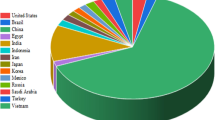Abstract
The hydration characteristics of pre-cast concrete considering the effects of effective initial steam-curing and water-curing duration were measured and analyzed with XRD, TG, X-ray CT, SEM-BSE and MIP techniques. The results show that the effective initial steam-curing duration for pre-cast concrete with lower water-binder ratio was 10–14 h at 50 °C and the initial water-curing duration was 7–14 d. And the hydration evolution of cement, fly ash and slag in pre-cast concrete was obtained respectively by combining the hydrochlorides and EDTA selecting dissolution methods, based on which the contents of hydrated and anhydrate in concrete were calculated and the corresponding dynamic capillary porosity was also determined. Moreover, the comparison between calculated results and experimental ones indicates that the proposed evolution models of microscopic characteristics corresponding to hydration kinetics of cemented materials could be adopted to predict the developing trend of capillary porosity and hydration-products content in pre-cast concrete with fly ash and slag under certain curing conditions.
Similar content being viewed by others
References
HUANG S Y, JIANG J F, YANG N Y. Modern concrete technology [M]. Xi’an: Shaanxi Press of Science and Technology, 2002. (in Chinese)
HU C Y, YUAN X M, GAO X S. Structure and performance of cement concrete [M]. Beijing: Chinese Construction Industry Press, 1984. (in Chinese)
JAWED I, SKALNY J. Hydration of tri-calcium silicate in the presence of fly ash [C]// Proceedings of Symposium N, Effects of Fly Ash Incorporation in Cement and Concrete, Boston: Materials Research Society, 1981: 60–70.
LIN F, MEYER M C. Hydration kinetics modeling of Portland cement considering the effects of curing temperature and applied pressure [J]. Cement and Concrete Research, 2009, 39(8): 255–265.
NAVI P, PIGNAT C. Simulation of cement hydration and the connectivity of the capillary pore space [J]. Advanced Cement Based Material, 1996, 4(2): 58–67.
BENTZ D P. Three-dimensional computer simulation of Portland cement hydration and microstructure development [J]. Journal of American Ceramic Society, 1997, 80(1): 3–21.
CERVERA M, FARIA R, OLIVER J, PRATO T. Numerical modeling of concrete curing, regarding hydration and temperature phenomena [J]. Computers and Structures, 2002, 80(18/19): 1511–1521.
SCHINDLER A K, FOLLIARD K J. Heat of hydration models for cementitious materials [J]. ACI Materials Journal, 2005, 102(1): 24–33.
PATEL H H, BLAND C H, POOLE A B. The microstructure of concrete cured at elevated temperatures [J]. Cement and Concrete Research, 1995, 25(3): 485–490.
TAYLOR H F W. Chemistry of cement [M]. 2nd ed. London: Thomas Telford Services Ltd., 1997.
LEA F M. Chemistry of cement and concrete [M]. 3rd ed. London: Edward Arnold Ltd., 1970.
PAPADAKIS V G. Effect of fly ash on Portland cement systems Part I. Low-calcium fly ash [J]. Cement and Concrete Research, 1999, 29(11): 1727–1736.
POWERS T C, BROWNYARD T L. Studies of the physical properties of hardened Portland cement paste [R]. Bulletin, vol. 22, Research Laboratories of the Portland Cement Association, Chicago, 1948.
LI X, YAN P Y. Assessment method of hydration degree of cement in complex binder based on the calcium hydroxide content [J]. Journal of the Chinese Ceramic Society, 2009, 37(10): 1597–1603.
PAPADAKIS V G. Effect of fly ash on Portland cement system part II: High-calcium fly ash [J]. Cement and Concrete Research, 2000, 30(10): 1647–1654.
SNYDER K A, BENTZ D P. Suspended hydration and loss of freezable water in cement pastes exposed to 90% relative humidity [J]. Cement and Concrete Research, 2004, 34(11): 2045–2056.
PANE I, HANSEN W. Investigation of blended cement hydration by isothermal calorimeter and thermal analysis [J]. Cement and Concrete Research, 2005, 35(6): 1155–1164.
SAEKI T, MONTEIRO P J M. A model to predict the amount of calcium hydroxide in concrete containing mineral admixtures [J]. Cement and Concrete Research, 2005, 35(6): 1914–1921.
Author information
Authors and Affiliations
Corresponding author
Additional information
Foundation item: Project(51308308) supported by the National Natural Science Foundation of China; Project(LQ12E08002) supported by the Natural Science Foundation of Zhejiang Province, China; Project(2012A610159) supported by the Natural Science Foundation of Ningbo City, China; Projects(XKL11D2081, zj1113) Subject Program of Ningbo University, China; Project(2010R50034) supported by the Key Science and Technology Innovation Team Program of Zhejiang Province, China; Project supported by K.C Wong Magna Fund in Ningbo University
Rights and permissions
About this article
Cite this article
Ba, Mf., Qian, Cx. Hydration evolution of pre-cast concrete with steam and water curing. J. Cent. South Univ. 20, 2870–2878 (2013). https://doi.org/10.1007/s11771-013-1808-0
Received:
Accepted:
Published:
Issue Date:
DOI: https://doi.org/10.1007/s11771-013-1808-0




